Iaidō (居合道), abbreviated iai (居合), is a Japanese martial art that emphasizes being aware and capable of quickly drawing the sword and responding to sudden attacks.

Kenjutsu (剣術) is an umbrella term for all (ko-budō) schools of Japanese swordsmanship, in particular those that predate the Meiji Restoration. Some modern styles of kendo and iaido that were established in the 20th century also included modern forms of kenjutsu in their curriculum. Kenjutsu, which originated with the samurai class of feudal Japan, means "methods, techniques, and the art of the Japanese sword". This is opposed to kendo, which means "the way of the sword" and uses a bamboo sword (shinai) and protective armour (bōgu).

Tenshin Shōden Katori Shintō-ryū (天真正伝香取神道流) is one of the oldest extant Japanese martial arts, and an exemplar of bujutsu. The Tenshin Shōden Katori Shintō-ryū was founded by Iizasa Ienao, born in 1387 in Iizasa village, who was living near Katori Shrine at the time. The ryū gives 1447 as the year it was founded, but some scholars state that it was about 1480.

Nagakura Shinpachi was the former captain of the 2nd troop of the Shinsengumi, He was later known as Sugimura Yoshie during the Meiji era.

Nakayama Hakudō, also known as Nakayama Hiromichi, was a Japanese martial artist and founder of the iaidō style Musō Shinden-ryū. Received hanshi ranks in kendō, iaidō, and jōdō from the All Japan Kendo Federation. In addition, he held an instructor's license in Shintō Musō-ryū and a Menkyo kaiden in Shindō Munen-ryū making him the 7th sōke of that system. Nakayama was also one of the masters of the Shimomura-ha Musō Shinden Eishin-ryū, iaijutsu.
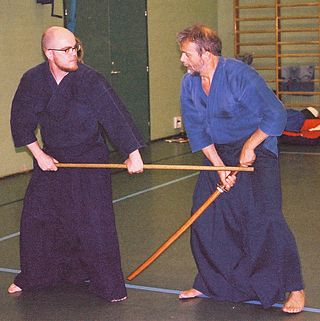
Shintō Musō-ryū, or Shindō Musō-ryū (神道夢想流), most commonly known by its practice of jōdō, is a traditional school (koryū) of the Japanese martial art of jōjutsu, or the art of wielding the short staff (jō). The technical purpose of the art is to learn how to defeat a swordsman in combat using the jō, with an emphasis on proper combative distance, timing and concentration. The system includes teachings of other weapon systems which are contained in Shintō Musō-ryū as auxiliary arts. The school is sometimes abbreviated as SMR.
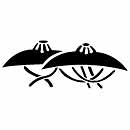
Yagyū Shingan-ryū (柳生心眼流), is a traditional school (koryū) of Japanese martial arts. Different styles of Yagyū Shingan-ryū, such as Heihojutsu and Taijutsu, assert different founders, Takenaga Hayato and Araki Mataemon respectively, but they all go back to Ushū Tatewaki, referred to in some historical scrolls as Shindō Tatewaki, who taught a system based on Sengoku-period battlefield tactics, that was called Shindō-ryū.

Uchida Ryōgorō Shigeyoshi, , was a Japanese jojutsu practitioner, ranked menkyo in the Japanese martial art of Shintō Musō-ryū. He is the creator of the gendai budo Uchida Ryu Tanjojutsu, originally known as Sutteki jutsu or "stick method".
Sekiguchi-ryū (関口流), or Sekiguchi Shin Shin-ryū (関口新心流), is a Japanese martial art founded in the mid-17th century, notable for its Kenjutsu, Iaijutsu, and Jujutsu, including the art of kyusho-jutsu.

Shindō Yōshin-ryū (新道楊心流), meaning "New Willow School" is a traditional school (ko-ryū) of Japanese martial arts, teaching primarily the art of jūjutsu. The first kanji of the name originally translated into "新=New", but in the mainline branch the kanji for "new" was eventually changed into the homophonic "神=sacred". The name of the school may also be transliterated as Shintō Yōshin-ryū, but the koryu tradition should not be confused with the modern school of Shintōyōshin-ryū which is unconnected.
Sōsuishi-ryū (双水執流) is a traditional Japanese martial art founded in 1650 that focuses on Kumi Uchi (jujutsu) and Koshi no Mawari. The title of the school also appears in ancient densho as Sōsuishi-ryū Kumi Uchi Koshi No Mawari(双水執流組討腰之廻) and in the book Sekiryūkan No Chōsen, which was approved and published by the Shadanhōjin Sekiryūkan in 2003. In the Bugei Ryūha Daijiten, Sōsuishi-ryū is cross referenced and listed under the entry/title of "Futagami-ryū." It includes a brief categorization, history and description of the school.
Yōshin-ryū (楊心流) is a common name for one of several different martial traditions founded in Japan during the Edo period. The most popular and well-known was the Yōshin-ryū founded by physician Akiyama Shirōbei Yoshitoki at Nagasaki Kyushu in 1642. The Akiyama line of Yōshin-ryū is perhaps the most influential school of jūjutsu to have existed in Japan. By the late Edo Period Akiyama Yōshin-ryū had spread from its primary base in Fukuoka Prefecture Kyushu, throughout Japan. By the Meiji era, Yōshin-ryū had spread overseas to Europe and North America, and to Australia and South Africa by the late Shōwa era.
Shintō Musō-ryū, or Shindō Musō-ryū (神道夢想流) is a traditional (ko-ryū) school of the Japanese martial art of jōjutsu, the art of handling the Japanese short staff (jō). The art was created with the purpose of defeating a swordsman in combat using the jō, with an emphasis on proper distance, timing and concentration. Additionally, a variety of other weapons are also taught.
Mugai-ryū or "Outer Nothingness School" is a Japanese koryū martial art school founded by Tsuji Gettan Sukemochi (辻月丹資茂) on 23 June 1680. Its formal name is Mugai Shinden Kenpō (無外真伝剣法).
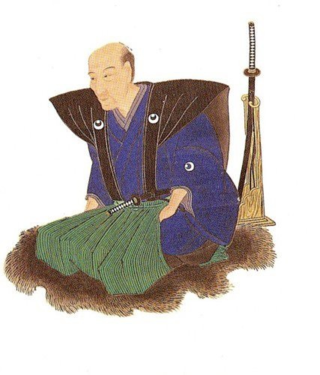
Hokushin Ittō-ryū Hyōhō (北辰一刀流兵法) is a koryū (古流) that was founded in the late Edo period (1820s) by Chiba Shusaku Narimasa. He was one of the last masters who was called a Kensei.
Fumon Tanaka is a traditional Japanese martial arts practitioner who holds a number of Soke positions in Japanese schools of martial arts. Specialising in various weapon forms and unarmed fighting methods. He is also an author and has appeared in numerous world media.
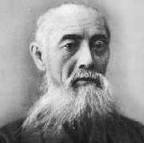
Negishi Shingorō 根岸信五郎 was a Samurai from Nagaoka Han in feudal Japan, was the 6th and last headmaster of the Shindō Munen-ryū from the feudal era of Japan, where this school of Japanese swordsmanship has its origin.
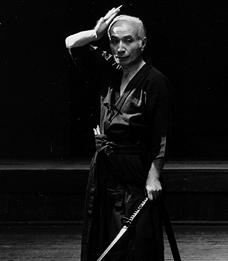
Saitō Satoshi was the 5th generation Sōke of Negishi-ryū, a classical Japanese warrior tradition and the nation's last surviving specialist school of Shurikenjutsu. From 1997 to 2014, Saitō served as the elected Chairman of the Nihon Kobudō Shinkōkai, Japan's oldest classical martial arts association. In addition, Saitō was the 6th generation head of Shirai-ryū shurikenjutsu and the 15th Sōke of Kuwana Han-den Yamamoto-ryū Iaijutsu. In 1992, Saitō was awarded the Imperial Order of the Sacred Treasure.

Sakakibara Kenkichi, was a Japanese samurai and martial artist. He was the fourteenth headmaster of the Jikishinkage school of sword fighting. Through his Jikishinkage contacts he rose to a position of some political influence; he taught swordsmanship at a government military academy and also served in the personal guard of Japan's last two shōguns.
Ryōi Shintō-ryū Jūjutsu 良移心当流 柔術, is a traditional school of Jujutsu (柔術), founded in the early 17th century by Fukuno Shichirouemon Masakatsu (福野七郎右衛門正勝).











